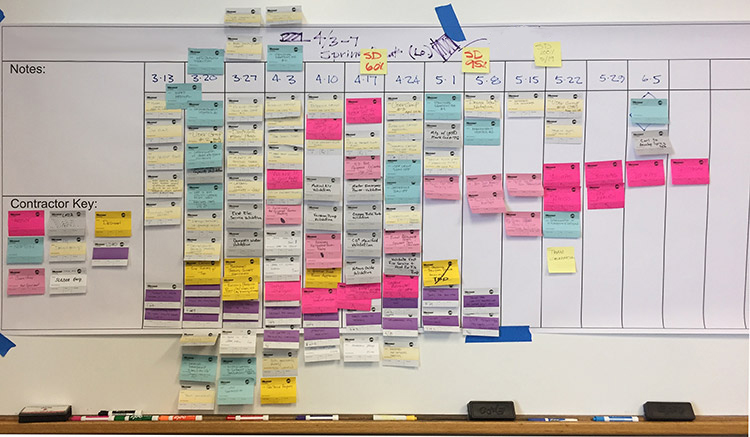Ten questions with Sherm Moreland on how Lean methodology improves collaboration and provides outcomes in design and construction
As DesignGroup looks ahead toward a thriving, sustainable future, we have carefully considered ways in which we can improve processes and provide further value to our clients. As a demonstration of our culture and ideals that a collaborative team approach is the ideal way to work, we recently completed four months of Lean training for our entire staff. Lean is a systematic way of thinking and acting to identify and deliver value through the client’s perspective and eliminate waste from the system. Lean is credited with turning Toyota into a leading car manufacturer after World War II, but it provides benefits for both manufacturing and services-oriented industries. The focus is placed on improving efficiency and productivity while respecting the role that employees play in the process.
While this firmwide training was a tremendous undertaking, it underscores DesignGroup's bedrock beliefs in:
- Collaborative work
- Open, honest and rhythmic communication
- Transparency
- Respect for people
- Elimination of rework
- Leading the effort of learning and innovation
- Bias for action and getting things done
Reflecting on this training and what it means for our team and clients moving forward, DesignGroup’s CEO, Sherm Moreland, answered ten questions on what Lean methodology is all about and what it means to DesignGroup.
1. What is your background with Lean and what inspired you to have the entire firm trained?
My Lean journey started in 1982. I worked as the in-house draftsman for a 200-person manufacturing plant during high school and college. It was my sole responsibility to design efficiencies that would eliminate waste and save time. Fast forward to 2008, as a healthcare planner and architect I joined three other DesignGroup colleagues in a Lean project management certification course. At the time, one of our clients was working with a group of industrial engineers to help eliminate waste and improve operational efficiencies. I saw improvements made within their system and saw potential for how I could apply this to healthcare planning, programming and design. Since 2008, our industry has started to embrace ideas of Lean design and construction to the point where it just made sense to train the entire team in the benefits of thinking and working in Lean ways.

2. Tell me more about what the training entailed.
We divided the firm up into two manageable groups for training and with the help of a Lean consultant/training coach, we spent six weeks focusing on selected book readings from the Lean Construction Institute. This culminated in a two-day workshop that summarized key learnings and created a prioritized action plan both in external project work and internal organizational operations.
Too often in organizational training sessions, a firm only sees issues from their point of view. To broaden our perspective, we invited several of our long-term clients to participate in the training with us. We really believe that value is defined by our clients and understanding this from their point of view was incredibly beneficial for all of us.
3. What is the easiest Lean tool to implement? What first appealed to DesignGroup staff?
That's a great question. Most people want to jump right into the tools. To be successful, we first need to understand foundational changes in culture that pave the path to success. During our workshop, staff defined over 50 ways to improve daily work. Thirty percent of those issues were related to improved communication, including:
- Making it visual
- Involving the entire team from the beginning
- Embracing constructive criticism
- Shifting away from blame to working as a team to making improvements
4. How do you ensure follow-through on lessons learned from the Lean training?
Since leadership starts at the top, it’s imperative that I am applying these Lean qualities and leading by example. It’s also important for me to work with the rest of our leadership team to ensure they're having similar conversations so the importance of this behavior is driven into the culture of the organization. The good news is, we aren't starting from scratch. Most of us already implement some of aspects of Lean, so the training was a great reinforcement to challenge the status quo and to align the entire organization around Lean tools and system. We believe culture is a continuous process and we will remain dedicated to regularly sharpening these skills.
5. How has it changed DesignGroup’s process during projects?
For me, the proof came when seeing several of our internal teams implement key tools such as pull plans, daily huddles and concluding meetings with plus/delta evaluations. It was great to see teams grabb ahold of ways to instantly improve communication and work holistically to prioritize project tasks and schedules. Now the challenge is to ensure this is happening consistently on every project and that we share these stories internally to continuously improve.
6. You mentioned a Lean pull plan. Can you explain that in more detail?
The value in a pull plan is to take bite-sized chunks of project deliverables and detail out the sequence of work required. This ensures that the necessary work dependencies are understood by the entire team—not just the leadership. This is a visual way for everyone to participate in understanding the commitments of individual team members through a dynamic schedule. This is also an extremely useful tool for teams to develop good communication habits with understanding for their team mates’ other commitments.
Lean teaches us to 'go slow to go fast'. By taking the time in the beginning to create a pull plan, subsequent work effort can move quickly with a lower occurrence of duplicative effort and rework.

7. How will Lean benefit DesignGroup internally?
Nearly every client is asking us to deliver higher quality work at a lower cost and shorter timeframe. While there are specific internal efficiencies we work on at DesignGroup, we are always aligned with how we can deliver value to our clients. The benefits of these improvements are related to internal team communication and planning of the work.
One exciting outcome from our training was the energy from our staff. It’s important that every voice is heard when it comes to collaborating on ways we can continuously improve our organization. Lean training teaches us to come to the table on equal ground in relation to importance of contributions. We believe that this type of communication will not only be a benefit internally, but it will reflect in our quality of work.
8. What resources would you recommend to clients that want to begin a Lean journey?
As I mentioned earlier, it’s natural to want to jump right in and start using the tools. However, to establish something sustainable, it's important to start with culture. In the book, 2 Second Lean by Paul Akers, there is an example where a trainer says ”we're going to scrub floors”. The trainee is upset and says, “But I came to learn about Lean”. The point of this story is no job is more important than another. It’s important to begin by understanding what your team does and try to view your company from their perspective. It’s important to get everyone on board so I would suggest getting this input from staff and sharing with them where you are going as a firm. Cultural change is a long process and it’s important to remember everyone has a stake in it.
As a firm focused on continuous improvement, DesignGroup had implemented Dr. W. Edwards Deming’s “theory of management” and “system of profound knowledge” for over 15 years. These approaches to leadership, management and systems for improvement include Lean principles that drive toward both the growth of the firm and our employees.
9. Now that the training is complete, what is next for DesignGroup’s Lean journey?
Lean teaches about continuous improvement and reflection. Through input from staff, our firmwide training culminated in 12 things we want to work on as an organization—six internal process and communication elements and six things in our projects with consultants and clients. We have a lot of work ahead of us now. With those 12 things, we have moved from the education to the implementation phase of our Lean journey. We have staff volunteers who are teamed up with senior leadership members to take a deeper dive to build culture around the 12 areas of improvement for further development. While this is a long-term process, we benefited from instant take-aways such as improved communication around understanding the needs of team members to collaborate successfully and ways in which we can define value with clients at the beginning of projects.
10. What does this mean for clients?
Our Lean process started with consideration of our clients' interests. We began by asking how we could create a consistent client experience through all team members in each of the markets we serve. Lean teaches lessons about communication, defining value and eliminating waste. These are enduring values, paramount to success, in addition to being great architects and designers. Projects improve when there is a crystal clear vision or project charter established from the onset. If the team gets this right, the opportunity for success skyrockets.


Sherm Moreland // CEO
Sherm is a design-oriented leader who has devoted his entire career to the programming and planning of award-winning, complex healthcare projects nationwide. He is a Board Certified Healthcare Architect, a Lean Certified Project Manager, speaks and publishes nationally, and is a frequent contributor to research of the Advisory Board Company. With over 26 years of focused experience in healthcare, clients benefit from his unique depth of industry specific knowledge and understanding of the ever-changing trends that lead to best practice thinking and innovation. He has published and presented nationally on issues related to healthcare design, sustainability, and corporate leadership. Sherm firmly believes in having a bias for action and the value of teamwork and collaboration as the best path for enduring project success.
